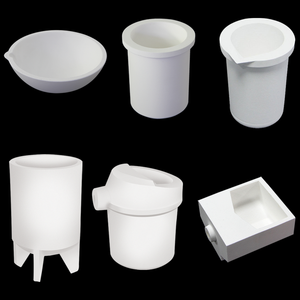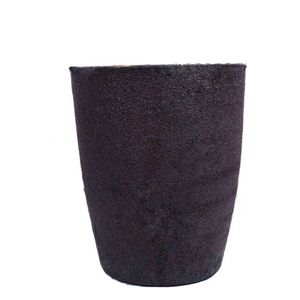Professional industry ceramic supplier, silicon nitride, silicon carbide, aluminum nitride and any other kinds of ceramics.
PRODUCT PARAMETERS
Description
Overview of Smelting Ceramic Crucible
Smelting Ceramic Crucible are specialized containers designed for withstanding extremely high temperatures in laboratory and industrial settings. They are essential for processes such as melting, calcining, and heat-treating a wide variety of materials, including metals, glasses, and chemicals. Our crucibles are engineered for superior thermal stability and chemical resistance, ensuring purity and reliability in the most demanding applications.
Features of Smelting Ceramic Crucible
-
Exceptional Thermal Shock Resistance: Withstands rapid temperature changes without cracking, ensuring durability and a long service life.
-
High-Temperature Stability: Maintains structural integrity at extreme temperatures, often exceeding 1500°C.
-
Excellent Chemical Inertness: Resists corrosion and reaction with molten metals, acids, and aggressive chemical fluxes.
-
High Purity & Low Contamination: Manufactured from premium materials to prevent sample contamination during sensitive processes.
-
Optimized Thermal Properties: Designed for efficient heat transfer and consistent performance in furnace environments.
-
Robust Mechanical Strength: Offers good resistance to physical impact and abrasion during handling and use.
Specifications of Smelting Ceramic Crucible
Smelting ceramic crucibles manage very heats. They melt metals. These crucibles are available in different sizes. The size relies on how much metal you require to thaw. Typical dimensions range from small laboratory sizes to big commercial ones. Crucibles have a common form. They are typically cylindrical with a level bottom. This shape promotes also home heating. Crucibles can be found in different capabilities. Abilities are measured in kilos or liters. They hold the liquified steel cost.
The material matters greatly. Crucibles are commonly made from high-purity alumina or graphite-clay mixes. These products withstand severe warmth. Crucibles stand up to temperature levels well above usual melting points. They manage temperature levels surpassing 1700 ° C. This is vital for thawing steels like copper or brass. Crucibles stand up to chemical strike. The molten steel does not quickly damage the crucible wall surfaces. This guarantees purity.
Thermal shock resistance is crucial. Crucibles heat up and cool down continuously. They should not fracture under this stress and anxiety. Good crucibles make it through numerous heating cycles. Surface area high quality is important also. Crucibles have smooth internal surfaces. This prevents steel from sticking. It makes pouring much easier. Crucible wall surfaces are thick sufficient. This gives toughness. The density makes certain the crucible lasts much longer. Crucibles are steady on heating system bottoms. They will not tip conveniently.
Crucible option depends upon the steel. Various metals require various crucibles. Inspect the specifications before buying. Make certain the crucible matches your heating system type. Crucible life varies. It relies on use and care. Proper handling expands crucible life. Always follow security treatments. Crucibles are crucial devices for steel casting.
Applications of Smelting Ceramic Crucible
Smelting ceramic crucibles are important devices in high-temperature metal processing. They deal with extreme warm well. Many markets rely on them daily. Fashion jewelry makers make use of ceramic crucibles for melting precious metals. Gold, silver, and platinum require trusted melting vessels. These crucibles use the needed security. Crucibles are essential in oral labs also. Dental professionals thaw alloys for crowns and bridges. A dependable crucible ensures pureness and consistency. Shops make use of bigger ceramic crucibles. They thaw significant amounts of steel. Iron, steel, light weight aluminum, and copper prevail examples. The crucible has to endure the extreme heater environment. Crucibles are important for steel recycling. Scrap steel needs thawing down for reuse. Ceramic crucibles manage this requiring task properly. They are likewise made use of in r & d. Scientists discover new steel alloys. Crucibles give a controlled setting for experiments. The aerospace sector relies on specialized steel components. Developing these often begins with melting in a crucible. Crucibles are basic for casting procedures. Molten metal is poured right into molds. The crucible functions as the intermediary container. Glassmakers sometimes use ceramic crucibles as well. They melt specific glass batches requiring heats. Crucibles supply a recyclable remedy for numerous melting tasks. Their durability reduces replacement costs. Proper crucible selection is important for any type of melting application. Matching the crucible to the metal and temperature is essential. This makes certain safety and security and performance in the workshop or manufacturing facility.
Company Profile
Tanki New Materials Co.Ltd. focus on the research and development, production and sales of ceramic products, serving the electronics, ceramics, chemical and other industries. Since its establishment in 2015, the company has been committed to providing customers with the best products and services, and has become a leader in the industry through continuous technological innovation and strict quality management.
Our products includes but not limited to Aerogel, Aluminum Nitride, Aluminum Oxide, Boron Carbide, Boron Nitride, Ceramic Crucible, Ceramic Fiber, Quartz Product, Refractory Material, Silicon Carbide, Silicon Nitride, ect. please feel free to contact us.

Payment Methods
T/T, Western Union, Paypal, Credit Card etc.
Shipment Methods
By air, by sea, by express, as customers request.
5 FAQs of Smelting Ceramic Crucible
What are smelting ceramic crucibles?
These are containers made from special ceramics. People use them to melt metals. They handle very high heat well. Metals like gold, silver, copper, and aluminum melt inside them.
Why use ceramic instead of metal crucibles?
Ceramic crucibles last longer under intense heat. Metal crucibles might melt or break down faster. Ceramic resists chemical reactions with molten metal better. This means cleaner melts. They also heat up more evenly.
What temperatures can ceramic crucibles handle?
They are very tough against heat. Different ceramic types have different limits. Some handle around 2000°F. Others withstand over 3000°F. Always check the specific rating for your crucible. Never exceed the maximum temperature listed.
How do I pick the right crucible size?
Consider the amount of metal you need to melt. Crucibles come in many sizes. Choose one that holds more than your metal charge. Metal expands when melted. Leaving space at the top prevents spills. Too small is unsafe.
What safety steps are important?
Wear protective gear always. Use gloves and eye protection. Heat the crucible slowly. Sudden temperature changes cause cracks. Never add cold metal to hot molten metal. This causes dangerous splashes. Let the crucible cool completely before handling or cleaning.
REQUEST A QUOTE
RELATED PRODUCTS

99.9% High Purity Ceramic Alumina Crucible Pot for Aluminium Melting Furnace

High Purity Ceramic Crucibles Boron Nitride 99.7%

Alsint C799 Al2o3 99.7% Alumina Ceramic Crucible for Glass Melting Pot 5 buyers

High Temperature Carbon Sulfur Analyzer SiO2 Silica Ceramic Crucible

Haichen 2L Big Volume Ceramic Crucible for Melting Glass Platinum Golden Iron


